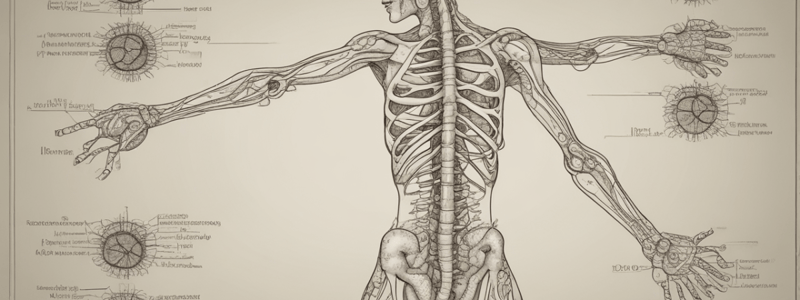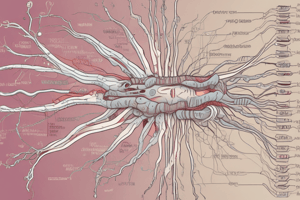Podcast
Questions and Answers
What is the expected outcome when the sympathetic nervous system is active?
What is the expected outcome when the sympathetic nervous system is active?
What is the type of neuron that originates from the CNS and travels to the ganglion?
What is the type of neuron that originates from the CNS and travels to the ganglion?
What is the neurotransmitter involved in the transmission of signals in the parasympathetic nervous system?
What is the neurotransmitter involved in the transmission of signals in the parasympathetic nervous system?
What is the term for the bundle of nerve fibers that arise from the spinal cord and innervate the peripheral ganglia?
What is the term for the bundle of nerve fibers that arise from the spinal cord and innervate the peripheral ganglia?
Signup and view all the answers
What is the region of the spinal cord where the sympathetic nervous system is primarily located?
What is the region of the spinal cord where the sympathetic nervous system is primarily located?
Signup and view all the answers
What is the function of the junction where the neuron and muscle meet?
What is the function of the junction where the neuron and muscle meet?
Signup and view all the answers
What is the effect of Bobrum toxin on the neuromuscular junction?
What is the effect of Bobrum toxin on the neuromuscular junction?
Signup and view all the answers
What is the outcome of organophosphatas poisoning on the neuromuscular junction?
What is the outcome of organophosphatas poisoning on the neuromuscular junction?
Signup and view all the answers
What is the role of the motor end plate in the neuromuscular junction?
What is the role of the motor end plate in the neuromuscular junction?
Signup and view all the answers
What is the effect of curare on the neuromuscular junction?
What is the effect of curare on the neuromuscular junction?
Signup and view all the answers
What is the type of muscle that is under voluntary control?
What is the type of muscle that is under voluntary control?
Signup and view all the answers
What is the location of the cell bodies of motor neurons in the voluntary nervous system?
What is the location of the cell bodies of motor neurons in the voluntary nervous system?
Signup and view all the answers
What is the term for the junction between a neuron and a skeletal muscle fiber?
What is the term for the junction between a neuron and a skeletal muscle fiber?
Signup and view all the answers
What is the term for the degeneration of motor neurons, leading to muscular paralysis?
What is the term for the degeneration of motor neurons, leading to muscular paralysis?
Signup and view all the answers
What is the structure that forms the junction between the neuron and the muscle fiber?
What is the structure that forms the junction between the neuron and the muscle fiber?
Signup and view all the answers
What is the type of potential generated in the muscle fiber in response to neurotransmitter release?
What is the type of potential generated in the muscle fiber in response to neurotransmitter release?
Signup and view all the answers
Flashcards
Neuromuscular Junction
Neuromuscular Junction
The connection where motor neurons meet skeletal muscles to transmit signals.
Motor Neurons
Motor Neurons
Neurons that carry signals from the CNS to skeletal muscles for contraction.
Voluntary Control
Voluntary Control
The ability to consciously control muscle movements via motor neurons.
End Plate Potential
End Plate Potential
Signup and view all the flashcards
Acetylcholine
Acetylcholine
Signup and view all the flashcards
Autonomic Nervous System
Autonomic Nervous System
Signup and view all the flashcards
Sympathetic Nervous System
Sympathetic Nervous System
Signup and view all the flashcards
Parasympathetic Nervous System
Parasympathetic Nervous System
Signup and view all the flashcards
Neurotransmitters
Neurotransmitters
Signup and view all the flashcards
Botulinum Toxin
Botulinum Toxin
Signup and view all the flashcards
Amyotrophic Lateral Sclerosis (ALS)
Amyotrophic Lateral Sclerosis (ALS)
Signup and view all the flashcards
Ventral Horn
Ventral Horn
Signup and view all the flashcards
Skeletal Muscle
Skeletal Muscle
Signup and view all the flashcards
Fight or Flight
Fight or Flight
Signup and view all the flashcards
Relaxation Response
Relaxation Response
Signup and view all the flashcards
Chemical Messengers
Chemical Messengers
Signup and view all the flashcards
Study Notes
Neuromuscular Junction
- The neuromuscular junction is the point where the motor neuron and skeletal muscle meet, and it is responsible for transmitting signals from the neuron to the muscle.
- The signal is transmitted through the release of chemical messengers (neurotransmitters) from the terminal bouton of the motor neuron, which binds to receptors on the muscle cell membrane.
- The binding of neurotransmitters to receptors generates an end plate potential, which leads to muscle contraction.
Motor Neurons
- Motor neurons are responsible for transmitting signals from the central nervous system (CNS) to skeletal muscles, resulting in muscle contraction.
- Motor neurons are under voluntary control, meaning they can be controlled consciously.
- The cell bodies of motor neurons are located in the ventral horn of the spinal cord, and their axons transmit signals to the skeletal muscles.
Autonomic Nervous System
- The autonomic nervous system is responsible for controlling involuntary functions, such as heart rate, digestion, and respiration.
- The autonomic nervous system has two branches: sympathetic and parasympathetic.
- The sympathetic nervous system is responsible for the "fight or flight" response, and originates from the thoracic and lumbar regions of the spinal cord.
- The parasympathetic nervous system is responsible for promoting relaxation and reducing stress, and originates from the cranial and sacral regions of the CNS.
Neurotransmitters
- Acetylcholine (ACh) is a neurotransmitter that plays a crucial role in the transmission of signals from motor neurons to skeletal muscles.
- ACh is released from the terminal bouton of the motor neuron and binds to receptors on the muscle cell membrane, leading to muscle contraction.
- ACh can be blocked by certain toxins, such as botulinum toxin, which can cause muscle paralysis.
Diseases
- Amyotrophic lateral sclerosis (ALS) is a disease that affects the motor neurons, leading to muscle weakness and paralysis.
- ALS is characterized by the destruction of the motor neurons and their axons, leading to a loss of muscle function.
Studying That Suits You
Use AI to generate personalized quizzes and flashcards to suit your learning preferences.
Description
Test your knowledge of the autonomic nervous system, including sympathetic and parasympathetic nerves, ganglia, and neurotransmitters. Learn about the structure and function of this complex system. Identify the different types of nerves and their roles in the body.




